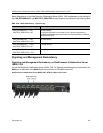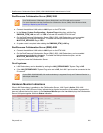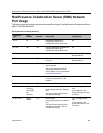
RealPresence Collaboration Server (RMX) 1500/1800/2000/4000 Administrator’s Guide
Polycom®, Inc. 505
The Hardware Monitor Status indications are summarized in the following table:
Network Traffic Control
The Network Traffic Control mechanism controls the level of UDP packets generated by the system. It
regulates a set of queuing systems and mechanisms by which UDP packets are received and transmitted
to the network router.
During a conference the MPMx cards occasionally blast-out UDP packets which can cause overloads on
the network. Collaboration Server bandwidth usage can increase to above the designated conference
participant line rate settings, causing network bandwidth issues such as latency and packet loss.
Three Network Traffic Control Flags are used to control the Network Traffic mechanism:
● ENABLE_TC_PACKAGE -
When the flag is set to NO (default), Network Traffic Control is disabled on the Collaboration Server.
Set the flag to YES to enable Network Traffic Control.
● TC_BURST_SIZE -
This flag regulates the Traffic Control buffer or maxburst size as a percentage of the participant line
rate. In general, higher traffic rates require a larger buffer. For example, if the flag is set to 10 and the
participants line rate is 2MB, then the burst size is 200Kbps.
Default = 10
Flag range: 1-30.
● TC_LATENCY_SIZE -
This flag limits the latency (in milliseconds) or the number of bytes that can be present in a queue.
Default = 500
Flag range: 1-1000 (in milliseconds).
RTM LAN Indications
Status Description
Active The LAN port cable is connected.
Inactive The LAN port cable is not connected.
Standby The LAN Redundancy option is enabled and this LAN port is the redundant and in
standby mode. In case of failure, this port becomes active.
Only supported in the MPMx Card Configuration mode.


















